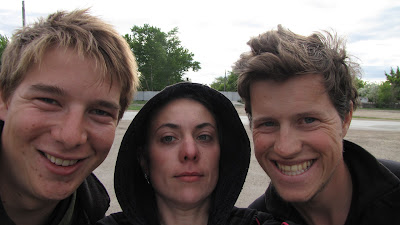In an earlier blog post we wrote about the Ibuttons
(temperature loggers) in the nest while the female is incubating. This is doing
fine now and we have put loggers in 28 nests. We already see nice incubation patterns, but also strange things. For example in the morning of 12 May there was heavy rain. During the rain all the females stayed on the nest (good parenting). After the rain, when the females must have been soaked, all birds with loggers left the nest for about 1.5 hours! The need for foraging apparently was very high. During normal days we see different strategies. Some birds leave the nest for a long period in the early morning and in the evening, some birds only leave the nest for shorter periods. Very interesting stuff to look into!
Another way to see whether dung is beneficial for the microclimate we have put 12 loggers inside left (predated or successful) nests and 12 loggers just 30 cm outside the nest. In this way we see how the microclimate differs between the cups and a random spot outside the nest. Preliminary results are that the minimum temperature is about 2 degrees higher in nests than outside the nest and the maximum temperature is 7 degrees lower in the nests. Both is beneficial for the female, eggs and chicks. We do not know the main cause behind this buffering effect yet.
Then a short note on the other things than Black Larks. We keep our eyes open during the fieldwork and afterwards. In this way we found Caspian Plovers on migration (rather scarce here), many many White-winged Terns and Little Stints and the Ruffs are becoming very numerous. Also, there is a nice group (approx. 300 ind) of Rosy Starlings around the village. The most stunning bird we saw was a male Crested Honey-buzzard on the 16th, which was only the second record for this area or more to say Central Kazakhstan. More to follow soon!
We can imagine that people are also interested in how the non-project things happen. Well, we all stay in so called homestays, so at home with locals. Here, we are adopted as family and provided with good local food and the occasional banja (sauna). Thomas and Thijs are living together with Timur and Ruslan. Ruslan is the project coordinator on Sociable Lapwings (ACBK), from which we get much assistance on logistics and information about the use of dung in Sociable Lapwings. Timur also works for the Sociable Lapwing project and also works at the Korgalzhyn Nature Reserve. Gera is staying in another homestay with Boris, who works at the Korgalzhyn Nature Reserve and there a lot people from the Sociable Lapwing project stay for one or few days.
 |
| Group of Rosy Starlings in the garden of the place where Gera stays |
 |
| Lunch in the field! |
 |
| We are still happy :) |
 |
| Adult male Crested Honey-Buzzard |

Well done guys for finding so many nests and putting out a lot of loggers. The variation in incubation strategies seems remarkable, some females seem to be off the nest a heck of a long time! The pattern above looks as if actually overheating of the clutch during mid-day was more of a problem for them than low temperatures. Will be very interesting to relate dung abundance and cover to these patterns later.
ReplyDeleteKeep on the good work - Johannes
That'S Perfect. Great research
ReplyDelete